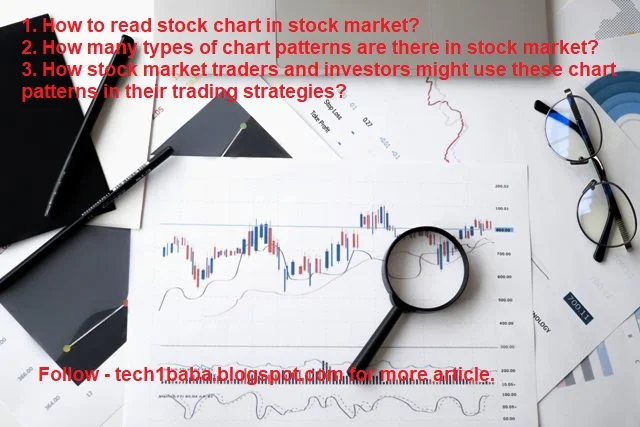 |
| How to read stock chart in stock market? |
Table of Contents :
- The most important part in the stock market is reading stock chart in stock market.
- How many types of chart patterns are there in stock market?
- How stock market traders and investors might use these chart patterns in their trading strategies?
The most important part in the stock market is reading stock chart in stock market.
- Choose a charting tool : There are many free and paid charting tools available online. Some popular options include Trading View, Yahoo Finance, and Google Finance.
- Select the time frame : Charts can show stock prices over different time frames, such as one day, one week, one month, or several years. Choose a time frame that is relevant to your investment goals and trading strategy.
- Analyze the price movements : Look for trends in the stock's price movements, such as uptrends (higher highs and higher lows) or downtrends (lower highs and lower lows). Also, pay attention to support and resistance levels, which indicate prices at which buyers or sellers tend to enter or exit the market.
- Use technical indicators : Technical indicators are tools that can help you analyze price movements and make trading decisions. Common indicators include moving averages, relative strength index (RSI), and MACD (moving average convergence divergence).
- Consider other factors : Charts are just one tool in your investing toolbox. Be sure to consider other factors that can impact stock prices, such as earnings reports, economic indicators, and news events.
Remember that stock chart reading is not an exact science and there is always some degree of uncertainty in the stock market. However, by using charts and other tools to analyze stock prices you can make more informed investment decisions. One important thing is that practice of using stock chart makes you more perfect.
How many types of chart patterns are there in stock market?
There are many types of chart patterns in the stock market and each pattern can provide different information to traders and investors. Here are some of the most common chart patterns :
- Trend patterns : These patterns show the overall trend of a stock, including uptrends, downtrends, and sideways trends.
- Reversal patterns : These patterns indicate a potential reversal in the current trend, such as a head and shoulders pattern or a double top/bottom pattern.
- Continuation patterns : These patterns suggest that the current trend will continue, such as a flag or pennant pattern.
- Support and resistance patterns : These patterns show key levels at which a stock has historically found support or resistance, such as a horizontal support or resistance line or a trendline.
- Candlestick patterns : These patterns use Japanese candlestick charts to show the open, high, low, and close prices for a stock, and can indicate potential reversals or continuation of trends.
- Volume patterns : These patterns use trading volume to provide information about the strength of a trend or potential reversals.
These are just a few examples of the types of chart patterns in the stock market. Traders and investors may use a combination of these patterns as well as other technical and fundamental analysis tools to make informed investment decisions.
How stock market traders and investors might use these chart patterns in their trading strategies?
- Trend patterns : Traders might use trend patterns to identify the overall direction of a stock's price movement and make trades that align with the trend. For example a trader might look for an uptrend pattern on a chart and buy the stock expecting the price to continue rising.
- Reversal patterns : Traders might use reversal patterns to identify potential turning points in a stock's price movement and make trades that take advantage of these changes. For example a trader might look for a head and shoulders pattern on a chart and sell the stock expecting the price to start falling.
- Continuation patterns : Traders might use continuation patterns to identify opportunities to enter or add to a position in a stock that is trending in a certain direction. For example a trader might look for a flag pattern on a chart and buy the stock expecting the price to continue rising after a period of consolidation.
- Support and resistance patterns : Traders might use support and resistance patterns to identify key levels where the stock is likely to find support or resistance and make trades accordingly. For example a trader might look for a stock to bounce off a support level on a chart and buy the stock expecting the price to rise.
These are just a few examples of how stock chart patterns might be used in live trading. However, it is important to note that no trading strategy is foolproof and all investments involve some degree of risk. It is important to thoroughly research any investment opportunities and consult with a financial advisor before making any investment decisions.
You may also like below articles :
Also read : Everything about Mutual Funds.
Also read : Everything about Demat Account.
Also read : Is Nasdaq 100 Index a good investment ?
Also read : About Indian Stock Market
Also read : What time does the stock exchange open?
No comments:
Post a Comment